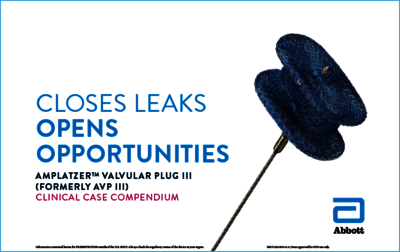VALVULAR PLUG III
STRUKTURELLE INTERVENTIONEN
Paravalvuläre Lecks (PVLs) sind weltweit ein häufiges und schwieriges Problem.1
Der Amplatzer™ Valvular Plug III wurde speziell entwickelt, um eine Vielzahl von Morphologien zu verschließen und die Lebensqualität und Lebenserwartung einer wachsenden Zahl von Patient:Innen zu verbessern.2-5
EINE WIRKSAME LÖSUNG FÜR EINE BREITE PALETTE VON PVL-MORPHOLOGIEN2,6,7
Paravalvuläre Lecks (PVLs) können in einer Vielzahl von Formen und Größen vorkommen. Der Amplatzer™ Valvular Plug III wurde in einer asymmetrischen, länglichen Form entwickelt, die für eine Vielzahl von PVLs geeignet ist, um die Lecks unterschiedlicher Morphologien zu verschließen. So kann der Amplatzer™ Valvular Plug III bei bis zu 93 % der Patient:Innen einen wirksamen Verschluss gewährleisten.1, 5, 6
TV
HUB
- Rama-Merchan J, Arribas-Jimenez A, et al. Prevalence and severity of paravalvular regurgitation in the Artificial Valve Endocarditis Reduction Trial (AVERT) echocardiography study. Rev Esp Cardiol. 2014;67:593-596.
- Ruiz CE, Hahn RT, Berrebi A, et al. Clinical trial principles and endpoint definitions for paravalvular leaks in surgical prosthesis: an expert statement. J Am Coll Cardiol. 2017;69(16):2067-2087. doi.org/10.1016/j.jacc.2017.02.038.
- Calvert PA, Northridge DB, Malik IS, et al. Percutaneous device closure of paravalvular leak: combined experience from the United Kingdom and Ireland. Circulation. 2016;134(13):934-944. doi.org/10.1161/CIRCULATIONAHA.116.022684.
- García E, Arzamendi D, Jimenez-Quevedo P, et al. Outcomes and predictors of success and complications for paravalvular leak closure: an analysis of the SpanisH real-wOrld paravalvular LEaks closure (HOLE) registry. EuroIntervention. 2017;12(16):1962-1968. https://doi.org/10.4244/EIJ-D-16-00581.
- Davidavicius G, Rucinskas K, Drasutiene A, et al. Hybrid approach for transcatheter paravalvular leak closure of mitral prosthesis in high-risk patients through transapical access. J Thorac Cardiovasc Surg. 2014;148(5):1965-1969. doi.org/10.1016/j.jtcvs.2014.05.001.
- Smolka G, Pysz P, Jasinski M, et al. Multiplug paravalvular leak closure using Amplatzer Vascular Plugs III: a prospective registry. Catheter Cardiovasc Interv. 2016;87(3):478-487. doi.org/10.1002/ccd.25992.
- Yildirim A, Goktekin O, Gorgulu S, et al. A new specific device in transcatheter prosthetic paravalvular leak closure: a prospective two-center trial. Catheter Cardiovasc Interv. 2016;88(4):618-624. doi.org/10.1002/ccd.26439.
- Angulo-Llanos R, Sarnago-Cebada F, Rivera AR, et al. Two-year follow up after surgical versus percutaneous paravalvular leak closure: a non-randomized analysis. Catheter Cardiovasc Interv. 2016;88(4):626-634. doi.org/10.1002/ccd.26459.
- Data on File at Abbott.
- Sánchez-Recalde A, Moreno R, Galeote G, et al. Immediate and midterm clinical course after percutaneous closure of paravalvular leakage. Rev Esp Cardiol (Engl Ed). 2014;67(8):615-623. doi.org/10.1016/j.rec.2014.01.031.


